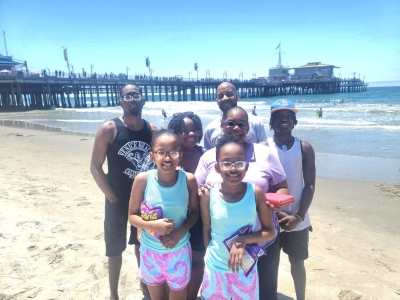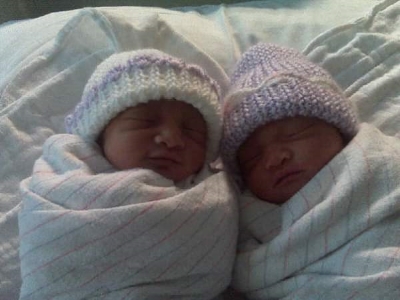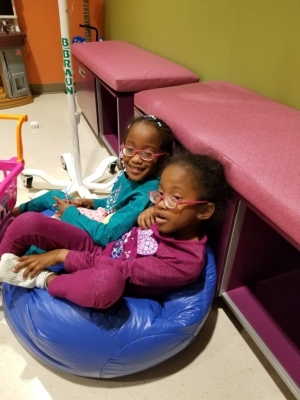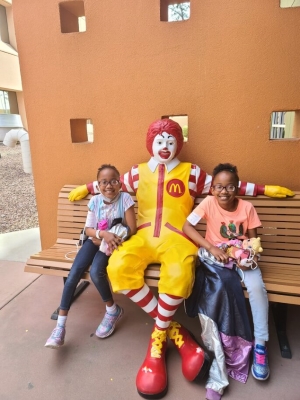Bright Futures
Articles and Updates from Phoenix Children's
In the heartwarming journey of Karma and Kiana Wainwright, twin sisters with sickle cell disease, a remarkable source of salvation emerged – their older brother, Khamal.
Their inspiring story of sibling love and expert medical care is powerfully summarized by their mother, Kina: "There’s no doubt about it. My children are true warriors."
Sickle cell diagnosis and early challenges
The first few days of Karma and Kiana’s lives went smoothly, with minimal complications or reasons for concern. However, by the time they were two weeks old, both sisters had swelling in their hands and feet.
Following a check-up with their pediatrician, Kina received a surprising diagnosis for both of her newborn twins – sickle cell anemia. It was a condition she didn’t know much about but knew had serious implications.
Sickle cell disease is a hereditary, chronic blood disorder that alters the shape and functionality of red blood cells. This leads to episodes of intense pain, referred to as sickle cell crises, often triggered by factors like infections, stress or extreme temperatures.
As time passed, Karma and Kiana faced increasingly frequent and severe pain crises. At just nine months old, Karma was hospitalized due to severe respiratory obstruction and chest inflammation. Though she would recover, this event marked the onset of a challenging period between ages 2 and 6, during which both girls faced more recurring hospitalizations.
“Throughout their childhood, Karma and Kiana suffered from extreme bouts of pain in their stomachs and legs,” Kina said. “They would also get really high fevers. I was told they were at higher risk for stroke, heart disease, severe infections and other life-threatening conditions. They needed help, and I needed hope.”
It was at this time that Karma and Kiana transitioned into the care of the expert team at Phoenix Children’s Center for Cancer & Blood Disorders – which would prove to be a major turning point in their battle against pediatric sickle cell disease.
Discovering support for sickle cell at Phoenix Children's
“Every person we met – from doctors and nurses to child life specialists – made us feel comfortable and kept us informed,” Kina said. “I listened to them. They listened to me. We were a team. I trusted them right away.”
There were times when Karma and Kiana would be hospitalized together. Other times, one would be released from the hospital just as the other was being admitted. It was a challenging situation for any parent to manage, but Kina learned how to rely on the physician team to guide her and her daughters through a variety of procedures and treatments.
At one point, the girls were introduced to a common preventive medication for sickle cell patients called hydroxyurea, but their bodies did not respond to it, leaving their pain crises unresolved. Due to severe anemia, they needed blood transfusions often leading to iron overload and iron removal therapy.
Each pain crisis brought on a new series of challenges, and each time the physician team – spearheaded by hematologists Roberta Adams, MD, Alexander Ngwube, MD and Sanjay Shah, MD – met the challenge head on and worked toward managing the twins’ sickle cell symptoms.
Dr. Shah emphasized the importance of personalized care for sickle cell patients, stating, "Sickle cell disease is complex and affects each patient differently. Even though Karma and Kiana are twins and have many similarities regarding their sickle cell conditions, they each had unique complexities that required an individualized approach for each sister. We're thrilled about the progress they’ve made, both together and individually."
In addition to the medical care provided by the skilled team of hematologists, Phoenix Children’s child life specialists made sure the girls felt special during their hospital stays, offering activities and companionship that helped alleviate some of the fear and uncertainty that came with their condition. Kina even mentioned that her daughters enjoyed the experience so much that they eagerly looked forward to visiting the hospital again.
Despite the multidisciplinary team approach, Kina never lost sight of the reality her daughters faced. “Even though they were feeling supported, their lives were still at risk,” she recalled. “Something needed to happen to ensure a brighter future for my girls.”
New hope: bone marrow transplant as an option
The turning point came when the medical team discussed the possibility of a bone marrow transplant. The option was risky, and the process was intensive, but it offered the potential of a healthier life for Karma and Kiana. “The doctors explained the risks involved, and it was scary, but in my heart, I was all in. Their lives were on the line, and it was a chance to help them. My trust and faith were with the Phoenix Children’s team 100%,” Kina said.
A bone marrow transplant for sickle cell patients involves replacing the faulty bone marrow cells that produce abnormal hemoglobin with healthy donor cells. This procedure aims to provide patients with a new source of functional red blood cells, potentially alleviating the symptoms of sickle cell disease and improving overall health.
The family had to find a suitable donor. Five of Kina's children were tested, and remarkably, only one was a perfect match. Khamal, then 15 years old, willingly embraced the challenge. He saw the opportunity to work with the doctors to save his sisters' lives as an honor, even though it meant undergoing a series of blood tests, sometimes-painful procedures and an extended period of isolation to avoid getting ill himself. Next, the girls needed conditioning for the transplant, which involved a series of infusions and chemotherapy over several months.
During the procedure, stem cells harvested from Khamal were infused into their bodies, gradually replacing the faulty cells that had caused them so much pain. The process was not without its challenges, but the girls showed extraordinary resilience and determination.
The girls would receive their transplants a year apart, Kiana at age 7 and Karma at age 8. Following their transplants, Karma and Kiana's lives underwent a profound shift. The days of frequent hospitalizations, excruciating pain crises and stifling limitations were replaced with a newfound sense of freedom. Kina marvels at their change: “They now swim without restrictions, play in the dirt and sun, and explore the world without constraint. Their lab results stand as testament to their progress, reflecting the enrichment their lives have embraced.”
Since the successful transplants, their once-persistent pain crises and hospitalizations have become distant memories. Currently, the girls only go in for check-ups once a year, and their lives have taken on a semblance of normalcy that once felt out of reach. Thanks to their older brother, the twins are stronger than ever and forever bonded by the shared experience of conquering a challenging disease.
Karma and Kiana's journey stands as a testament to the remarkable fusion of patient resilience, the unbreakable bond of sibling love and the unwavering trust placed in a team of dedicated medical professionals.
Visit Phoenix Children’s Center for Cancer & Blood Disorders to learn more about the transformative work being performed to improve the lives of patients like Karma and Kiana.






